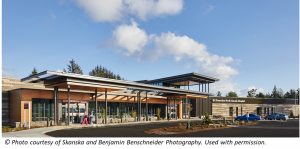Voice of Industry: Q&A with Skanska about building the future of healthcare
We recently connected with Skanska USA Building’s Vice President and Account Manager Todd Predmore, an Oregon Bio board member, to discuss how the global construction management company is working in the Pacific Northwest to shape the future of health technology, R&D and care.
Q: What capabilities are needed now to build cutting-edge health and technology facilities in the Pacific Northwest?
 A: Design and construction in the life sciences sector has long been a core competency at Skanska. Our local and global work focuses on envisioning and building research, academic, public and private life science communities with experience and proficiency. So many of the projects we do are part of long-term relationships with health systems and growing organizations to continue re-think, re-engineer and re-imagine how delivery of services can look. We have three objectives:
A: Design and construction in the life sciences sector has long been a core competency at Skanska. Our local and global work focuses on envisioning and building research, academic, public and private life science communities with experience and proficiency. So many of the projects we do are part of long-term relationships with health systems and growing organizations to continue re-think, re-engineer and re-imagine how delivery of services can look. We have three objectives:
- Build for a cure
- Build for speed to market
- Build for future users and generations to come
We work closely with companies looking to create better patient experiences, or modernize existing health, research lab or data storage spaces to understand the drive and the need for expanded services – whether it’s to accommodate more patients, new lab equipment, more room for research and development or increased server/data capacity and storage. The pandemic has impacted every health and tech operation, no matter the size. Typically, we work with owners through all phases of the imagining, planning, design, sourcing, construction and launch phases of their projects.
Q: How specifically does Skanska work to create environments that inspire the innovations of tomorrow?
A: We ask ourselves this question during each project.
In each Skanska project, we seek to source sustainable materials while implementing Lean concepts and processes to enhance efficiency and value. We support owners by helping them to manage energy and materials consumption not only throughout the building process but also in the long term, so our customers/owners benefit by environmentally-conscious and smart energy use. We work to reduce waste on the building site.
For example, we are completing one of the area’s largest data centers in Hillsboro which totals 358,000 square feet with a cooling efficiency with zero water usage.
In Hillsboro, we’re also completing a large clean room facility for a global high-tech manufacturer. In Lincoln City, we just completed construction on a brand new, 16-bed, accredited, critical access hospital and trauma care center that sought to completely revamp its service orientation to bring forth a true patient-centric design. We worked with hospital doctors, nurses, administration and the community to re-imagine how health care services could be differently distributed in ways to come directly to the patient, instead of the traditional methods of making the patient go to the services. The planning and design created a smaller footprint for the hospital while creating a better patient experience.
We collaborate with clients/owners on each step of the process, sharing best practices and offering solutions for challenges brought on by the pandemic.
Q: What specific changes are you seeing or employing in the built environment pertaining to the pandemic?
A: We work with clients/owners workflow changes to maintain safety protocols to ensure businesses stay open and operational. We are working to better automate processes and approvals, including opportunities to plan for the building planning and modeling processes using virtual and augmented reality. Many of our key customers want to automate more of their manufacturing processes and we can increase efficiencies and time to market.
By using Lean approaches, we can ensure schedules are maintained with overlap to meet specific timelines. Our clients/owners have access to paperless technology which allows real-time check ins in our building information and modeling systems. With careful planning and a true team-oriented approach, we can mitigate supply chain deficits and impacts.
Recently Skanska made an industry-leading global commitment to achieve net-zero carbon emissions in our operations and in the value chain by 2045 – that’s just 24 short years away. And we want to help our customers and partners commit to similar goals. We will not only help the environment, but we can help each other.
Our mission at Skanska is building what matters, which is why we focus on the life sciences, health care and high tech – we are striving to build for a better society and embracing the future. ###
